In both contrasted languages parts of the sentence


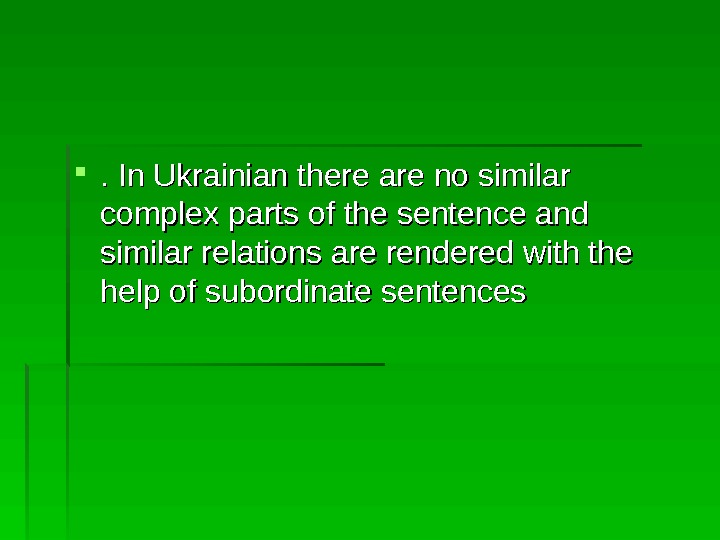

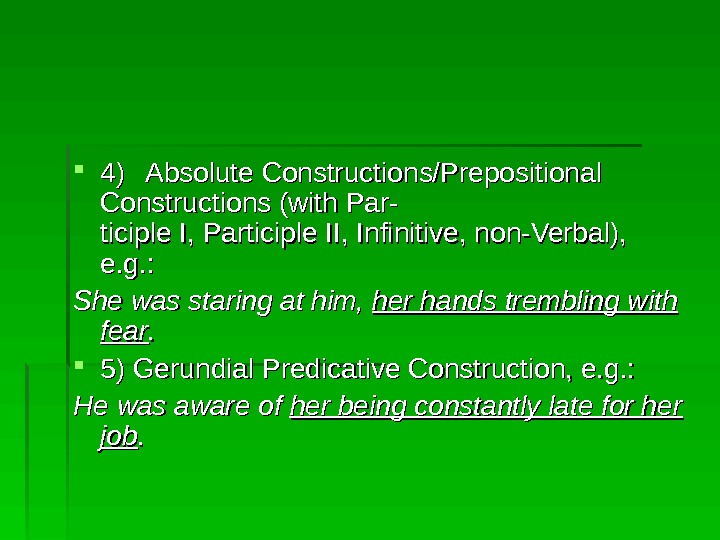
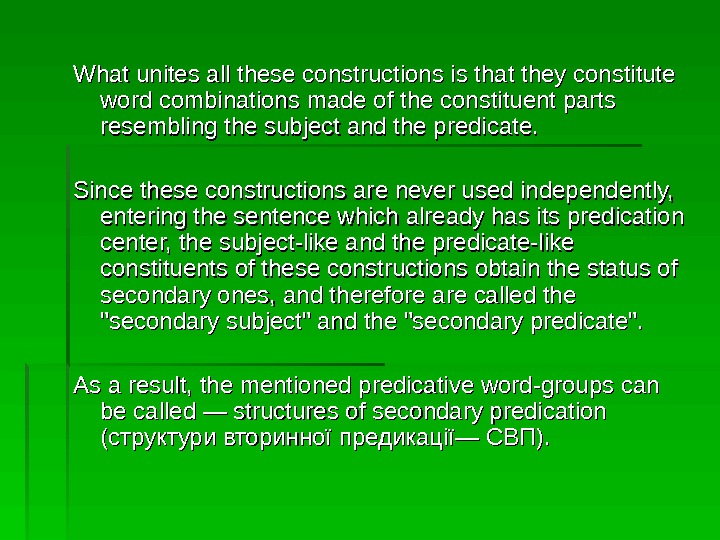

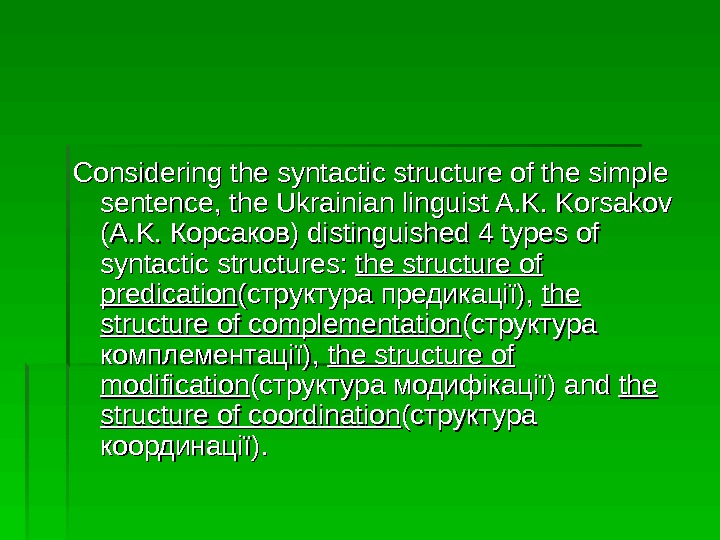

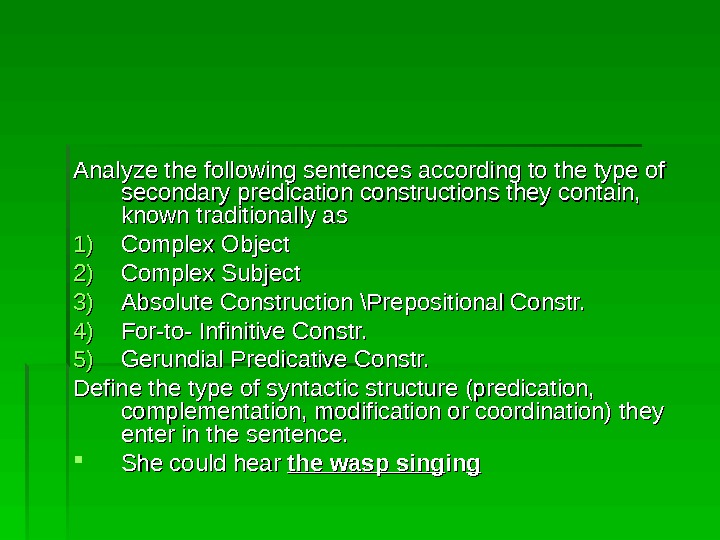
- Размер: 107 Кб
- Количество слайдов: 10
Описание презентации In both contrasted languages parts of the sentence по слайдам

 In both contrasted languages parts of the sentence are of similar types. But one of the peculiarities of the English syntax is the existence of the so called «complex» parts of the sentence. Each part of the modern English sentence can be simple or complex. The simple part of the sentence can be expressed not only by a separate word but also by a group of words that make up the lexical and grammatical unity. Unlike this the complex part of the sentence (e. g. , the Complex Subject, the Complex Object) are always the combination of two parts of the sentence, one of which points towards the person or the object, and the second — towards the action preformed by this person or object. Thus two members of the sentence that enter this complex are in predicate relations. Compare: I hate him to go away. Our arrival having been noted, we had a lot of guests.
In both contrasted languages parts of the sentence are of similar types. But one of the peculiarities of the English syntax is the existence of the so called «complex» parts of the sentence. Each part of the modern English sentence can be simple or complex. The simple part of the sentence can be expressed not only by a separate word but also by a group of words that make up the lexical and grammatical unity. Unlike this the complex part of the sentence (e. g. , the Complex Subject, the Complex Object) are always the combination of two parts of the sentence, one of which points towards the person or the object, and the second — towards the action preformed by this person or object. Thus two members of the sentence that enter this complex are in predicate relations. Compare: I hate him to go away. Our arrival having been noted, we had a lot of guests.
 . In Ukrainian there are no similar complex parts of the sentence and similar relations are rendered with the help of subordinate sentences
. In Ukrainian there are no similar complex parts of the sentence and similar relations are rendered with the help of subordinate sentences
 Thus, the mentioned complex parts of the English sentence are usually expressed with the help of predicative word groups, known in traditional grammars as: 1)1) Complex Object (with the Infinitive, Participle I, Participle II, Gerund, non-Verbal), e. g. : She wants him to study better. . 2)2) Complex Subject (with the Infinitive, Participle I, Participle II, non-Verbal), e. g. : The delegation was reported to have already arrived. . 3)3) For-to-Infinitive Construction, e. g. : For you to do this is of the utmost importance.
Thus, the mentioned complex parts of the English sentence are usually expressed with the help of predicative word groups, known in traditional grammars as: 1)1) Complex Object (with the Infinitive, Participle I, Participle II, Gerund, non-Verbal), e. g. : She wants him to study better. . 2)2) Complex Subject (with the Infinitive, Participle I, Participle II, non-Verbal), e. g. : The delegation was reported to have already arrived. . 3)3) For-to-Infinitive Construction, e. g. : For you to do this is of the utmost importance.
 4)4) Absolute Constructions/Prepositional Constructions (with Par- ticiple I, Participle II, Infinitive, non-Verbal), e. g. : She was staring at him, her hands trembling with fear. . 5) 5) Gerundial Predicative Construction, e. g. : He was aware of her being constantly late for her jobjob. .
4)4) Absolute Constructions/Prepositional Constructions (with Par- ticiple I, Participle II, Infinitive, non-Verbal), e. g. : She was staring at him, her hands trembling with fear. . 5) 5) Gerundial Predicative Construction, e. g. : He was aware of her being constantly late for her jobjob. .
 What unites all these constructions is that they constitute word combinations made of the constituent parts resembling the subject and the predicate. Since these constructions are never used independently, entering the sentence which already has its predication center, the subject-like and the predicate-like constituents of these constructions obtain the status of secondary ones, and therefore are called the «secondary subject» and the «secondary predicate». As a result, the mentioned predicative word-groups can be called — — structures of secondary predication (структури вторинної предикації— СВП).
What unites all these constructions is that they constitute word combinations made of the constituent parts resembling the subject and the predicate. Since these constructions are never used independently, entering the sentence which already has its predication center, the subject-like and the predicate-like constituents of these constructions obtain the status of secondary ones, and therefore are called the «secondary subject» and the «secondary predicate». As a result, the mentioned predicative word-groups can be called — — structures of secondary predication (структури вторинної предикації— СВП).
 Since Secondary Predication Structures are dependent ones and enter the sentence performing different syntactic functions, they can be classified according to the type of the syntactic structure they enter in the sentence. Before presenting this type of classification the types of syntactic structures should be mentioned.
Since Secondary Predication Structures are dependent ones and enter the sentence performing different syntactic functions, they can be classified according to the type of the syntactic structure they enter in the sentence. Before presenting this type of classification the types of syntactic structures should be mentioned.
 Considering the syntactic structure of the simple sentence, the Ukrainian linguist A. K. Korsakov (A. K. Корсаков ) distinguished 4 types of syntactic structures: the structure of predication (( структура предикації), the structure of complementation (структура комплементації), the structure of modification (структура модифікації) and the structure of coordination (структура координації).
Considering the syntactic structure of the simple sentence, the Ukrainian linguist A. K. Korsakov (A. K. Корсаков ) distinguished 4 types of syntactic structures: the structure of predication (( структура предикації), the structure of complementation (структура комплементації), the structure of modification (структура модифікації) and the structure of coordination (структура координації).
 Within the structure of complementation (consisting of the head-word and its comple ment) he distinguished the following types of complements : : The subjective complement or the predicative that characterizes the content of the substance-subject, e. g. : He is a student. . The objective complement , or the object-substance, which is in certain relations with the substance-subject expressed by the verb-predicate, e. g. : He studies languages. . The adverbial complement pointing towards certain characteristics of the verb-predicate, e. g. : He lives in Lviv. . The verbal complement which is the second verb component of the predicate, e. g. : He must study well.
Within the structure of complementation (consisting of the head-word and its comple ment) he distinguished the following types of complements : : The subjective complement or the predicative that characterizes the content of the substance-subject, e. g. : He is a student. . The objective complement , or the object-substance, which is in certain relations with the substance-subject expressed by the verb-predicate, e. g. : He studies languages. . The adverbial complement pointing towards certain characteristics of the verb-predicate, e. g. : He lives in Lviv. . The verbal complement which is the second verb component of the predicate, e. g. : He must study well.
 Analyze the following sentences according to the type of secondary predication constructions they contain, known traditionally as 1)1) Complex Object 2)2) Complex Subject 3)3) Absolute Construction \Prepositional Constr. 4)4) For-to- Infinitive Constr. 5)5) Gerundial Predicative Constr. Define the type of syntactic structure (predication, complementation, modification or coordination) they enter in the sentence. She could hear the wasp sing inin gg
Analyze the following sentences according to the type of secondary predication constructions they contain, known traditionally as 1)1) Complex Object 2)2) Complex Subject 3)3) Absolute Construction \Prepositional Constr. 4)4) For-to- Infinitive Constr. 5)5) Gerundial Predicative Constr. Define the type of syntactic structure (predication, complementation, modification or coordination) they enter in the sentence. She could hear the wasp sing inin gg
